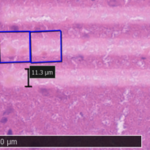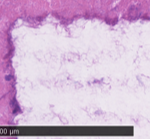A system designed for generating ultrafast mid-infrared laser pulses at the wavelength at which water molecules absorb light resonantly
Proposed use
Water is the most abundant molecule in biological tissue and absorbs light at 2.94 µm with very high efficiency (resonant absorption). The laser technology is tuned to this wavelength for highly efficient and localised absorption in any biological tissue at the laser focus. This absorption rapidly heats the sample in a very small region, causing rapid vaporisation and ultra precise tissue ablation, or removal.
As tissue absorbs the energy of the 10s – 100s picosecond pulses at the mid-infrared wavelength faster than the thermal and acoustic diffusion time of tissue, the technology, as shown below, enables highly precise ablation of tissue in the focus region whilst simultaneously minimising damage to the surrounding tissue. This collateral damage free ablation is a key advantage of the technology, and when compared to commonly used existing laser technology the differences are stark (see images below).
- Figure 1: More precise tissue ablation using the mid-infrared pulse laser technology. This image shows less damage to surrounding tissue compared to the standard laser used in Figure 2.
- Figure 2: damage to surrounding tissue using standard laser deployed in mass spectrometry applications
Applying more precise laser ablation of tissue to ionisation mass spectrometry imaging, preliminary experiments have demonstrated higher resolution imaging of tissue at the single-cell level. This capability would potentially improve diagnostic capabilities through access to higher resolution imaging.
Problem addressed
Based on current methods, the generation of mid-infrared picosecond light has generally been complex as it requires the integration of two laser sources that needs to be synchronised and carefully overlapped in space. This results in unreliable and complex systems that require frequent maintenance from a trained laser technician at a high cost in time and money.
The technology developed enables the generation of light at the mid-infrared wavelength with pulse durations in the 10s-100s of picosecond range, with near diffraction limited beam quality. The high beam quality of the laser allows us to perform high resolution single cell level mass spectrometric imaging, targeting the emerging field of single-cell metabolomics. The simple architecture of the system produces reliable high-quality beams in a field-deployable footprint.
Technology overview
The architecture of the system is based on the use of more reliable, longer-lifetime diode-pumped solid-state fibre pump lasers. Through nonlinear mixing of the input light, mid-infrared pulses at 2.94µm is achieved, which have been optimised for precise ablation of tissue at the single-cell level.
Benefits
- Robust system architecture producing high quality laser beam output at 2.94 µm
- Design enables development of compact and field-deployable mid-infrared laser source
- Picosecond mid-infrared pulses for tissue ablation reduces damage to surrounding cells as compared to standard ablation methods (nanosecond or longer pulses).
- Single-cell level mass spectrometry imaging for higher resolution imaging – see single cell metabolomics, one of Nature’s 2023 technologies to watch.
Intellectual Property information
PCT Application filed, September 26 2022




